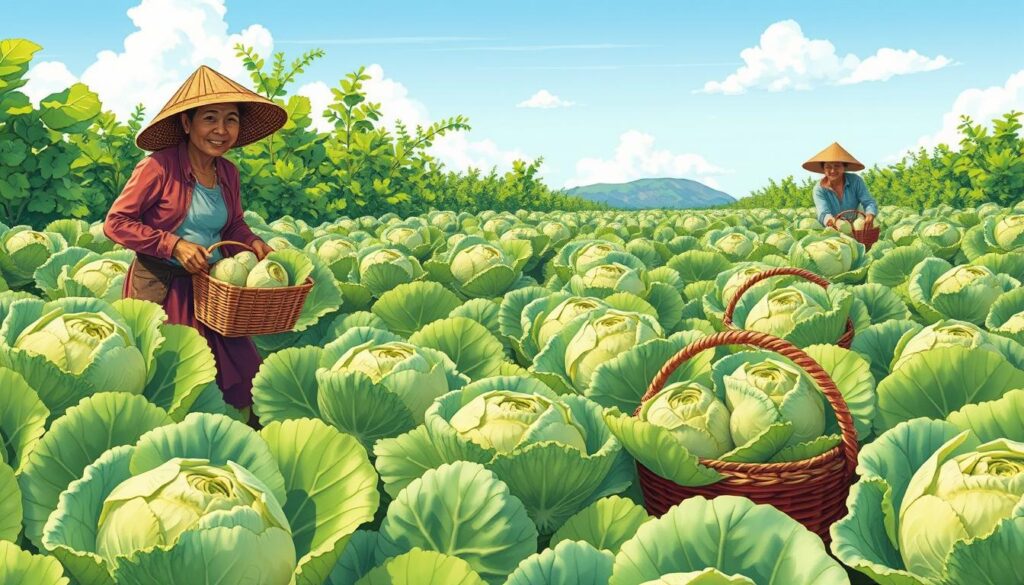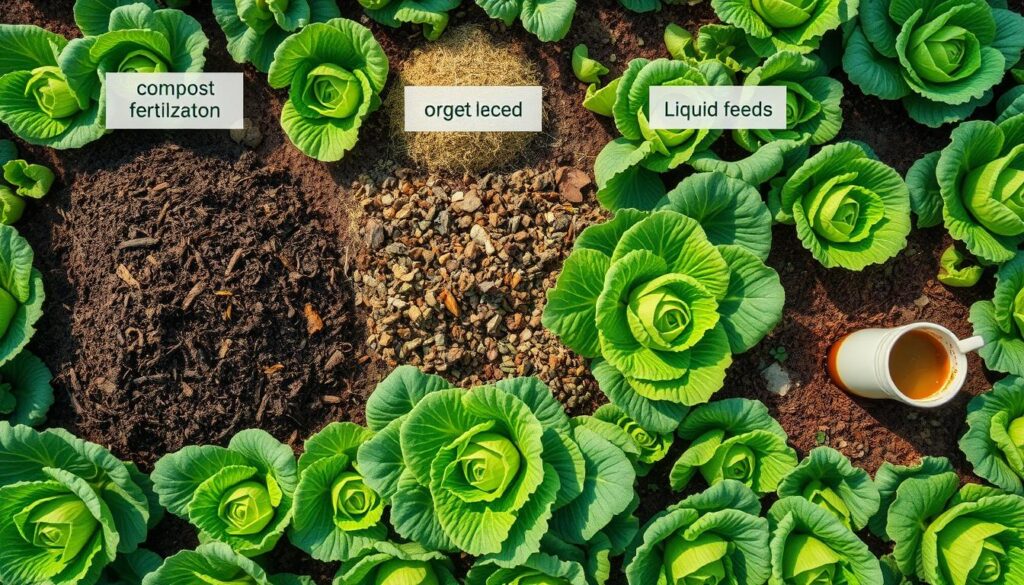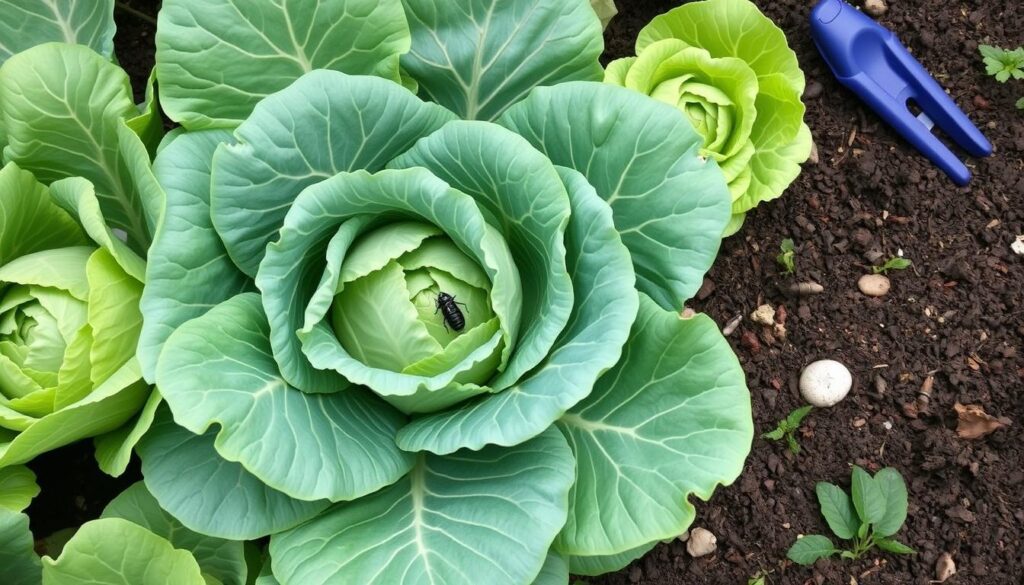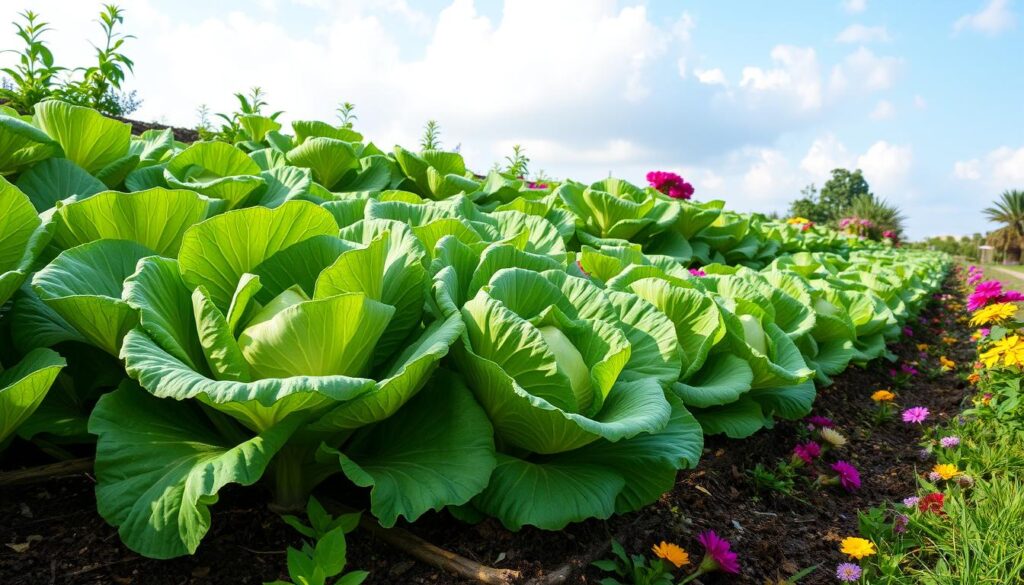Welcome to our guide on growing cabbage. It’s a rewarding hobby that can give you a lot of cabbage. We’ll cover the basics of growing cabbage, including its benefits and tips for success.
This guide is for both new and experienced gardeners. You’ll learn how to grow healthy, tasty cabbage. We’ll talk about choosing the right variety, understanding the growing process, and harvesting your crop.
Introduction to Growing Cabbage
Many gardeners wonder how to grow cabbage. The key is to understand the basics of growing it. It takes careful planning, attention to detail, and the right conditions for your plants to do well.
Key Takeaways
- Understand the basics of cabbage cultivation
- Choose the right cabbage variety for your climate
- Prepare the soil for optimal growth
- Provide adequate water and nutrients
- Monitor your plants for pests and diseases
- Harvest your cabbage at the right time
Understanding Cabbage Varieties and Their Growing Requirements
Cabbage comes in many shapes, sizes, and flavors. To grow it well, knowing the different types and their needs is key. Choosing the right variety for your garden helps your cabbage grow best.
When picking a cabbage type, think about temperature, soil, and moisture. Some cabbage likes cooler weather, while others prefer warmer. Knowing this helps you create the best spot for your cabbage plants.
Early Season Cabbage Types
Early season cabbage is great for spring or fall gardens. It grows fast, usually in 50-60 days, and doesn’t bolt easily. ‘Early Jersey Wakefield’ and ‘Golden Acre’ are good choices.
Mid-Season Varieties
Mid-season cabbage takes 70-80 days to grow. It’s a good mix of early and late varieties, giving you a longer harvest. ‘Danish Ballhead’ and ‘Savoy King’ are great mid-season picks.
Late-Season Cabbage Options
Late-season cabbage is perfect for winter gardens or storage. It takes 100-120 days to mature and fights off disease well. ‘January King’ and ‘Late Flat Dutch’ are top choices for late season.
By following these Cabbage Cultivation Tips and caring for your plants, you’ll get a big harvest of tasty cabbage. Always check the specific needs of your chosen variety for the best results.
Best Soil Preparation Techniques for Cabbage
To grow healthy cabbage, you need the right soil. It should be fertile and drain well. The best soil for cabbage has a pH of 6.0 to 7.0. It also needs organic matter and good drainage.
Testing the soil’s pH and nutrients is key. You can use a kit or send a sample to a lab. Then, add compost or manure to make the soil rich and balanced.
Here are some tips for the best soil for cabbage:
- Add organic matter for better soil structure and fertility.
- Use a balanced fertilizer for essential nutrients.
- Make sure the soil drains well to avoid waterlogging.
Soil preparation is the secret to great cabbage. With the right pH, nutrients, and structure, your garden will thrive. Using the best soil for cabbage means a big harvest of tasty and healthy cabbage.
How to Grow Cabbage from Seeds or Transplants
Growing cabbage from seeds or transplants needs careful planning. The Cabbage Growing Season starts in early spring or late summer. Knowing the best growing conditions and Cabbage Watering Schedule is key for a healthy crop.
Starting seeds indoors requires good light and a steady temperature. Direct sowing works too, but you need to prepare the soil well and water on time. Transplanting seedlings is a bit tricky, but it can help your crop grow strong and healthy.
- Soil quality and preparation
- Optimal temperature and light conditions
- Adequate watering and drainage
- Proper spacing and support
By following these tips and knowing your cabbage variety’s needs, you can have a great harvest. Don’t forget to watch your Cabbage Watering Schedule to keep your plants moist.
| Method | Advantages | Disadvantages |
|---|---|---|
| Starting seeds indoors | Early start, better control over conditions | Requires additional equipment and care |
| Direct sowing | Less equipment required, easier to establish | More susceptible to weather and soil conditions |
| Transplanting | Established seedlings, faster growth | Requires careful handling and soil preparation |
Ideal Growing Conditions for Healthy Cabbage
To get a great Cabbage Harvesting Guide, your cabbage needs the right conditions. This includes the right temperature, humidity, and light. Cabbage grows best in cooler temperatures, between 60 to 70 degrees Fahrenheit. It also likes a bit of humidity.
Good air circulation is key to avoid problems like bolting and tip burn. This helps your cabbage grow well and gives you a bigger harvest. Here’s what your cabbage needs to thrive:
- Temperature: 60-70 degrees Fahrenheit
- Humidity: 60-70%
- Light: Full sun to partial shade
- Air circulation: Good air circulation to prevent bolting and tip burn
By following these tips, you can make a perfect spot for your cabbage. Always check your cabbage for stress or disease signs. Act fast to stop any problems. With the right care, you’ll have a successful Cabbage Harvesting Guide.

Essential Watering Techniques for Cabbage Plants
Watering is key for growing cabbage. It helps prevent pests and diseases. Knowing when to water is important for a healthy crop.
A well-watered cabbage plant fights off pests and diseases better. It’s all about finding the right balance. Too little or too much water can harm the plant.
Watering Schedule for Different Growth Stages
The watering needs change as cabbage plants grow. Here’s a basic guide:
- Seedlings: Water lightly but often to keep seeds in place.
- Transplants: Water well after moving and keep soil moist for a few weeks.
- Mature plants: Water deeply but not too often to promote strong roots and avoid disease.
Signs of Over and Under-Watering
Knowing the signs of too much or too little water is key. Look out for these signs:
- Yellowing leaves: This means too much water, which can cause root rot.
- Wilting leaves: This is a sign of not enough water, stressing the plant and making it vulnerable to pests and diseases.
Fertilization Strategies for Optimal Growth
Fertilization is key for growing cabbage. It helps plants grow healthy and strong. Using the right fertilizers, at the right times, is important. Soil tests help figure out what nutrients are needed.
Here are some tips for fertilizing cabbage well:
- Choose a balanced fertilizer with nitrogen, phosphorus, and potassium.
- Feed your plants at planting time and again when they’re 6 inches tall.
- Test your soil often to see if you need to change your fertilizer plan.
By following these tips, you can give your cabbage the nutrients it needs. This will help them grow well and increase your harvest.
| Fertilizer Type | Application Rate | Timing |
|---|---|---|
| Balanced Fertilizer | 1-2 pounds per 100 square feet | At planting time and when plants are 6 inches tall |
| High-Nitrogen Fertilizer | 0.5-1 pound per 100 square feet | When plants are 12 inches tall |
Companion Planting with Cabbage
When it comes to Cabbage Cultivation Tips, companion planting is key. It’s about growing different plants together. This improves growth, fights pests and diseases, and boosts flavor. The right plants can make your garden balanced and thriving.
For the best Cabbage Plant Care, pair cabbage with marigolds and dill. Marigolds keep nematodes away, and dill attracts good bugs. Beans and mint are also great, as they offer shade and repel pests.
But, some plants don’t mix well with cabbage. Avoid broccoli and cauliflower because they share diseases. Tomatoes and fennel are also bad news, as they attract pests and slow down cabbage growth.
Adding companion planting to your Cabbage Cultivation Tips and Cabbage Plant Care routine is smart. It makes your garden diverse and strong. This method cuts down on pesticides and fertilizers, making it better for the planet.
Managing Common Cabbage Pests
Cabbage can face many pests like aphids, slugs, and snails. These can be tackled with natural pest control methods and Cabbage Pest Control techniques. Keeping your cabbage healthy starts with good Cabbage Fertilization Techniques and crop rotation.
Some common pests that affect cabbage include:
- Aphids
- Slugs
- Snails
To fight these pests, try natural pest control methods. Introduce beneficial insects like ladybugs. Use physical barriers, like fine mesh, to keep pests away. Also, using good Cabbage Fertilization Techniques helps your plants grow strong and pest-free.

Preventive steps like crop rotation and keeping your garden clean also help. By following these tips and using a mix of Cabbage Pest Control and Cabbage Fertilization Techniques, you can keep your cabbage healthy and pest-free.
Dealing with Cabbage Diseases
Cabbage can get sick with diseases like club root, downy mildew, and powdery mildew. These can really hurt the Cabbage Growing Season. To stop these diseases, it’s key to use the Best Soil for Cabbage and keep the soil healthy. This means rotating crops and keeping the area clean.
Here are some ways to fight cabbage diseases:
- Use cultural controls, like removing sick plants and improving air flow
- Apply chemical controls, like fungicides, when needed
- Try biological controls, like adding good microorganisms to the soil
By following these tips and being proactive, you can lower disease risks. This helps your cabbage grow strong and healthy.
Starting with the Best Soil for Cabbage and a good Cabbage Growing Season plan is key. Focus on soil health and disease prevention. This way, you’ll get a big harvest and enjoy growing cabbage.
Proper Spacing and Garden Layout
When growing cabbage, spacing and garden layout are key. A good layout ensures healthy growth and high yields. It also helps with air circulation, easy access, and weed control.
Row spacing is important. Rows should be 3 feet apart for easy walking. Plants within rows should be 12-18 inches apart, depending on the variety. This prevents overcrowding and diseases.

Following these tips and considering the Cabbage Watering Schedule and Harvesting Guide will help your garden thrive. With proper care, your cabbage will grow well, giving you a great harvest.
Seasonal Care and Maintenance
When growing cabbage, seasonal care is key for the best results. To give your cabbage the care it needs, knowing what to do in each season is important. How to Grow Cabbage is more than just planting and picking. It’s about caring for your plants all the way.
Important tasks for growing cabbage include pruning, training, and watching for pests and diseases. Keeping up with these tasks helps avoid problems and ensures a healthy crop. For instance, you can:
- Regularly check your plants for pests or diseases
- Use organic or chemical controls as needed to prevent infestations
- Keep your plants well-watered and fertilized
Also, keeping a record of your cabbage-growing experiences is helpful. By tracking your progress and noting successes and failures, you can improve your growing skills. As you learn and adapt, you’ll get better at how to grow cabbage.
Tips for Growing Cabbage in Containers
Growing cabbage in containers is a smart choice for small spaces. To succeed, follow key Cabbage Cultivation Tips. Choose a container that’s the right size and material. It should have good drainage and aeration for healthy growth.
Opt for a container that’s at least 6-8 inches deep. This allows for enough root growth. Use a well-draining potting mix for your container garden. Keep the soil moist but not too wet.
- Provide 4-6 hours of direct sunlight daily.
- Keep the temperature between 60-70°F (15-21°C).
- Water carefully to avoid overwatering, which can cause root rot.
By following these tips and strategies, you can have a successful cabbage harvest from your container garden.
When and How to Harvest Cabbage
Harvesting cabbage at the right time is key for the best taste and texture. Check the head’s size, color, and firmness to know when it’s ready. A mature cabbage head is firm, dense, and about 5-7 inches wide.
Good cabbage health comes from proper fertilization and pest control. Using balanced fertilizers helps the cabbage grow well. Effective pest control, like crop rotation and biological methods, keeps pests away.
Harvest Timing Indicators
- Head size: A mature cabbage head should be around 5-7 inches in diameter.
- Color: The cabbage head should be a deep green color, with no signs of yellowing or browning.
- Firmness: A mature cabbage head should be firm and dense, with no soft spots.
Proper Harvesting Techniques
To harvest cabbage, cut the head with a sharp knife or gardening tool. Leave a small stem part intact. This helps prevent rot and makes storage easier.
Storage Methods
Store cabbage in a cool, dry spot like a fridge or root cellar. It can last weeks and is great in salads and soups.
| Storage Method | Temperature | Humidity |
|---|---|---|
| Refrigerator | 32-40°F (0-4°C) | 80-90% |
| Root Cellar | 32-40°F (0-4°C) | 80-90% |
Troubleshooting Common Growing Problems
When growing cabbage, knowing common problems is key. The Cabbage Growing Season can bring challenges. Using the Best Soil for Cabbage is vital. It helps avoid root rot and nutrient issues.
Pests, diseases, and environmental stress can also affect your crop. Regular monitoring and keeping records are essential. This helps you spot patterns and prepare for future crops. Here are some tips for troubleshooting:
- Check your soil regularly to ensure it’s not too wet or dry.
- Inspect your plants for signs of pests or diseases, such as holes in the leaves or white powdery patches.
- Keep a record of any problems that arise and the solutions you use to address them.
By following these tips and using the Best Soil for Cabbage, you can reduce growing problems. This promotes healthy growth in your cabbage crop during the Cabbage Growing Season.
Conclusion: Growing Success with Your Cabbage Garden
Congratulations on starting your cabbage garden journey! You now know how to grow healthy, tasty cabbages. Keep an eye on your garden and be ready to solve any problems that come up.
With a little patience and effort, you’ll have a big harvest. You can make yummy coleslaw, stir-fries, or pickled cabbage with your own cabbage. Enjoy the joy of growing your own food and the delicious taste it brings.
Happy gardening! May your cabbage-growing adventures be successful and fun!
FAQ
What are the best soil preparation techniques for growing cabbage?
To grow healthy cabbage, start with good soil. It should drain well and be rich in nutrients. The pH should be between 6.0 and 7.5.
Add compost or well-rotted manure to make the soil better. Test your soil and fix it if needed. This ensures your cabbage grows well.
How do I grow cabbage from seeds or transplants?
You can start cabbage seeds indoors or directly in the garden. For indoor starting, sow seeds 6-8 weeks before the last frost. For direct sowing, plant seeds 1/2 inch deep and 12-24 inches apart.
When transplanting, pick healthy seedlings. Plant them at the same depth as in their container.
What are the ideal growing conditions for cabbage?
Cabbage loves cool, moist places with lots of sun. The best temperature is 60-75°F. Make sure it gets at least 1 inch of water a week.
Good air circulation helps prevent problems like bolting and tip burn.
How do I properly water and fertilize my cabbage plants?
Keep cabbage moist, but not wet, during head formation. Water deeply, about 1 inch per week. Fertilize with a balanced, slow-release fertilizer at planting and again in the middle of the season.
What are some common pests and diseases that affect cabbage, and how do I manage them?
Aphids, cabbage worms, and slugs are common pests. Use row covers, hand-pick pests, and introduce beneficial insects. Diseases like club root, black rot, and downy mildew can also be a problem.
Keep air moving, rotate crops, and choose disease-resistant varieties. This helps prevent these issues.
When and how should I harvest my cabbage crop?
Harvest cabbage when the heads are firm and fully grown. This is usually 60-100 days after transplanting. Cut the heads at the base, leaving 2-3 outer leaves attached.
Store the cabbage heads in the fridge or a cool, dark place for up to 3 months.
Share this post: on Twitter on Facebook

